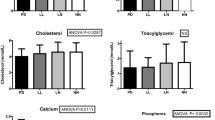Abstract
Background
Elastase-1 is a proteolytic enzyme secreted by pancreatic acinar cells, and measurements of the concentration this enzyme are used to evaluate pancreatic exocrine function. We aimed to determine whether pancreatic exocrine function declines due to chronic hypercalcemia by measuring fecal elastase levels.
Methods
75 patients with primary hyperparathyroidism (18 men and 47 women) and 30 healthy subjects (11 men and 19 women) participated in this study. Renal function tests, lipid parameters, bone mineral density, and serum calcium, phosphorus, vitamin D, parathormone, glucose, and thyroid stimulating hormone levels as well as fecal elastase concentrations, were determined in these patients and controls.
Results
The mean fecal elastase level was 335.3 ± 181.4 μg/g in the PHPT group and 317.4 ± 157.3 μg/g in the control group. There was no significant difference in fecal elastase levels between the two groups (p = 0.5).
Conclusions
Chronic hypercalcemia in primary hyperparathyroidism did not decrease the fecal elastase level, which is an indirect indicator of chronic pancreatitis; therefore, chronic hypercalcemia in PHPT may not cause chronic pancreatitis.



Similar content being viewed by others
References
Naruse S, Ishiguro H, Ko SBH et al (2006) Fecal pancreatic elastase: a reproducible marker for severe exocrine pancreatic insufficiency. J Gastroenterol 41:901–908
Stevens T, Conwell DL. Pancreatic exocrine function tests. http://www.uptodate.com/contents/pancreatic-exocrine-function-testssource=search_result&search=pancreatic+exocrine+function+tests&selectedTitle=1~7. Accessed June 2017
Sziegoleit A (1984) A novel proteinase from human pancreas. Biochem J 219:735–742
Stein J, Jung M, Sziegoleit A et al (1996) Immunoreactive elastase I: clinical evaluation of a new noninvasive test of pancreatic function. Clin Chem 42(2):222–226
Löser C, Mollgaard A, Folsch UR (1996) Faecal elastase 1: a novel, highly sensitive and specific tubeless pancreatic function test. Gut 39:580–586
Dominic R, Franzini C (2002) Fecal Elastase-1 as a test for pancreatic function: a review. Clin Chem Lab Med 40(4):325–332
Shane E, Dinaz I (2006) Hypercalcemia: pathogenesis, clinical manifestations, differential diagnosis and management. In: Favus MJ (ed) Primer on the metabolic bone disease and disorders of mineral metabolism, 6th edn. Lippincott, Williams, and Wilkins, Philadelphia, p 176
Marcocci C, Brandi ML, Scillitani A et al (2015) Italian society of endocrinology consensus statement: definition, evaluation and management of patients with mild primary hyperparathyroidism. J Endocrinol Invest 38:577–593
Mithöfer K, Fernandez-del Castillo C, Frick TW et al (1995) Acute hypercalcemia causes acute pancreatitis and ectopic trypsinogen activation in the rat. Gastroenterology 109(1):239–246
Bhadada SK, Updawat HP, Bhansali A et al (2007) Chronic pancreatitis in primary hyperparathyroidism: comparison with alcoholic and idiopathic chronic pancreatitis. J Gastoenterol Hepatol 28:959–964
Jacob JJ, Chacko A, Selvan B et al (2008) Primary hyperparathyroidism and chronic pancreatitis. J Gastroenterol Hepatol 233:164
Niederle B, Roka R, Woloszczuk W (1987) Successful parathyroidectomy in primary hyperparathyroidism: a clinical follow-up study of 212 consecutive patients. Surgery 102(6):903–909
Bess MA, Edis AJ, van Heerden JA (1980) Hyperparathyroidism and pancreatitis. Chance or a causal association? JAMA 243:246–247
Carnaille B, Oudar C, Pattou F (1998) Pancreatitis and primary hyperparathyroidism: forty cases. Aust NZ J Surg 68(2):117–119
Wolkowiak J, Nousia-Arvanitakis S, Cade A et al (2002) Fecal elastase-1 cut of levels in assessment of exocrine pancreatic function in cystic fibrosis. J Cystic Fibrosis 1(4):260–264
Bauer S, Amman R (1994) Chronic pancreatitis and primary hyperparathyroidism. Scweiz Med Wochenschr 124(30):1344–1348
Ward JB, Peterson OH, Jenkins SA et al (1995) Is an elevated concentration of acinar cytosolic free ionized calcium the trigger for acute pancreatitis? Lancet 346:1016–1019
Hart PA, Conwell DL (2015) Diagnosis of exocrine pancreatic insufficiency. Curr Treat Options Gastroenterol 13(3):347–353
Mann ST, Stracke H, Lange U et al (2003) Alterations of bone mineral density and bone metabolism in patients with carious grades of chronic pancreatitis. Metabolism 52(5):579–585
Moran CE, Sosa EG, Martinez SM et al (1997) Bone mineral density in patients with pancreatic insufficiency and steatorrea. Am J Gastroenterol 92:867–871
Author information
Authors and Affiliations
Corresponding author
Ethics declarations
Conflict of interest
The authors have no conflicts of interest to disclose.
Ethical approval
This study was approved by the Institutional Review Board of the Uludag University of the Turkey.
Human and animal rights
All procedures performed in studies involving human participants were in accordance with the ethical standards of the institutional and/or national research committee and with the 1964 Helsinki declaration and its later amendments or comparable ethical standards.
Informed consent
Our research involved human participants who had obtained informed consent.
Rights and permissions
About this article
Cite this article
Sisman, P., Avci, M., Akkurt, A. et al. The effect of primary hyperparathyroidism on pancreatic exocrine function. J Endocrinol Invest 41, 293–298 (2018). https://doi.org/10.1007/s40618-017-0727-6
Received:
Accepted:
Published:
Issue Date:
DOI: https://doi.org/10.1007/s40618-017-0727-6




